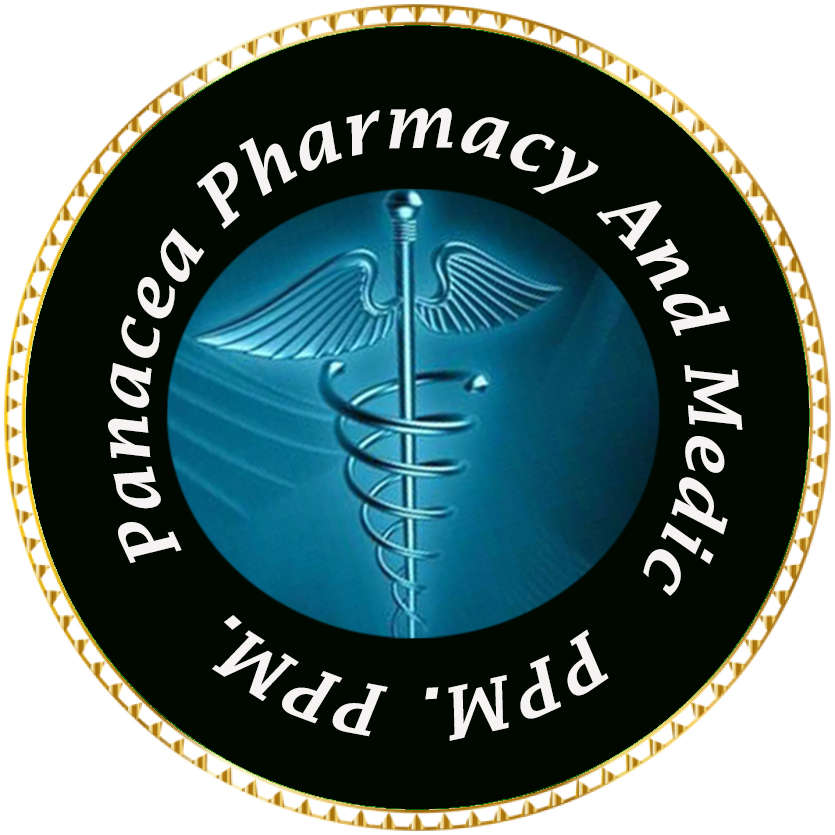Treatment of severe chronic obstructive pulmonary disease ( COPD).
Treatment of severe chronic obstructive pulmonary disease ( COPD).
what is sever COPD??
Severe chronic obstructive pulmonary disease (COPD) is an advanced stage of the disease where the symptoms are more intense and the lung function is significantly compromised. At this stage, managing the condition becomes more complex, and a comprehensive treatment plan is critical to improving quality of life and maintaining functionality.
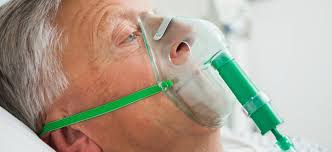
Symptoms
Physical finding
- Cough may produce.
- Dyspnea occurred it may sever.
- Sputum production it may also sever.
- FEV1/FVC < 50%, It may be reduced to 30%.
- FEV1 < 30%.
- Decrees concentration
- Skin becomes yellowish color due to lacking oxygen supply in the body.
- Bluer vision
Blood test
- Polycythemia
- WBC count may increase due to infection.
- Arterial blood gas studies
!. PaO2 level may decrease or not ( 30 to 45 mm Hg) !!. PaCO2 level may Increase or not ( 40 to 70 mm Hg) !!!. Decrease arterial pH seriously.
Spirometer test
- FEV1/FVC < 50% It may be near to 30%
- Increase residual lung volume
- Decrease vital capacity (VC)
- Decrease FEV1 <50% or near to 30%
Heart function test
a.Tachycardia may shown

Medication
4.1.Short acting β2 agonist
Eg. Albuterol Dose Nebulization: 2.5 mg with 3 ml 0.9N NaCl solution three to four times a day, over approximately 5 to 15 minutes by nebulizer machine. DPI: 1 to 2 inhalation each contain 180 mcq orally every 4 to 6 hours. Or
4.2. Short acting anticholinergic
Eg. Ipratropium Dose Nebulization:
500 mcg with 3 ml 0.9N NaCl solution three to four times a day, over approximately 5 to 15 minutes by nebulizer machine. MDI: One or two puff (20 mcg/puff) three or four times a day.
Or
4.3.Combination of long acting β2 agonist and Short acting anticholinergic.
Eg. Salbutamol + Ipratropium
Dose for Nebulization:
Salbutamol + Ipratropium (2.5 mg + 500 mcg ) with 3 ml 0.9N NaCl solution three to four times a day, over approximately 5 to 15 minutes by nebulizer machine.
- MDI:
One or two puff {Salbutamol + Ipratropium (20 mcg + 100 mcg )} two or three times a day. Indication: You can take any one of three above medication for 5 to 7 days or when exacerbation occurred. You should take or one or two puff as MDI 30 min before starting exercise. Note: I suggest taking 4 .3 no medicine of above should better choice of you. If fast line medicine does not work properly you should take second line medicine.
Second line medication:
5.1. Combination of short acting β-agonist (levalbuterol) and long acting anticholinergic (tiotropium).
a. Levalbuterol Dose for adult MDI:
2 puffs every 4 to 6 hours as needed. Nebulization: 0.63 to 1.25 mg with 3 ml 0.9N Nacl every 4 to 6 hours as needed up to 3 doses per 24 hours.
b. Tiotropium
Dose for adult MDI:
2 puffs per puff contain 1.25 mcg once a day as needed.
- Nebulization:
1.25 to 2.5 mcg with 3 ml 0.9N Nacl once per 24 hours. Note : If combination dose is not available You must take medication a and b individually, I nebulization combination solution may use. Nebulization should take 20 minutes interval for 1 hour and better to take when exacerbation or may take two times a day. Many of the country like Bangladesh this combination or individual medicine is not available. In this case I recommended another combination of medicine that are available. You should use this combination when fast combination or individual medicine is not available.
Medication:
5.2. combination of Salmeterol + Fluticasone Propionate
I suggest as MDI Doses: {Salmeterol ( 25 mcg) + Fluticasone Propionate(250 mcg)} per puff. Tow puffs two times a day.
5.3. Theophylline
Theophylline dose:
400 mg tablet form twice daily for 15 days to 1 month. You should use combination 5.1 with 5.3 medications simultaneously. If use combination 5.1 with 5.3 medications simultaneously and It could not work well you should add 5.2 medication with 5.1 & 5.3 medicine.
When your lung is infected by various bacteria or virus you should use antibiotics with above medicine.
Approximately 50% of exacerbations of COPD are associated with the isolation of bacteria from the lower respiratory tract.The dominant bacterium are; H. influenzae, S. pneumoniae and Moxarella catarrhalis. It is better to use antibiotics by screening test of various microorganism resistances. Without this screening test you may used antibiotics like –
5.4. Azithromycin Dose:
Tablet form of Azithromycin 500 mg once daily for 5 to 7 days. If your first antibiotics Azithromycin does not work well you should add 2nd antibiotics like levofloxacin with azithromycin.
5.5. Levofloxacin Dose:
Tablet form levofloxacin 500 mg once daily for 7 days.
How can you understand that you should need to take antibiotics???
Physical finding:
- Cough may produce.
- Dyspnea occurred slightly.
- Sputum production.
- Decrees concentration
Blood test
- WBC count may increase due to infection.
You may also added more medicine when your disease condition is very worse.
5.6. Steroid ( eg. Prednisolone)
Dose Tablet form of prednisolone 20 mg once or twice a daily.
Adult: 10-60 mg/day
Note: It should be concern about diabetics patient for using of steroid. It will need better for dose reduction.
5.7. Leukotriene Modifiers ( e.g. Montelukast)
Dose
Adult: 10 mg/ daily single dose
5.8. Cough exponent ( eg. Ambroxol)
Dose Syrup formation 10 ml each time for three times a day. Finally it is important to ensure oxygen supply at least 17 hours per day until development the dyspnea. It is better for patient to hospitalized.
Caution
When any COPD patient use above medication you should highly cautious.
Patient should avoid medicine who are:
- Chronic kidney patient
- Chronic liver disease patient
- Heart failure patient
- pregnant and lactation patient
Patient should partially cautious to taking medicine no 3.2,3.6 5.4, & 5.6 of above who are:
- strong diabetics patient
- Mild or moderate diabetics patient not need more cautious.
Patient should partially cautious to taking medicine no 1.2, 1.3, 2.2, 2.3, 3.1, 4.2, 4.3, 5.1 & 5.2 of above who are:
- Severe tachycardia patient like pulse rate more then 115 beat per minutes.
- Mild or moderate tachycardia patient not need more cautious.
Patient should partially cautious to taking medicine no 3.4 & 5.4 of above who are:
- Severe gastric, peptic or duodenum ulcer patient.
- Mild or moderate gastric, peptic or duodenum ulcer patient not need more cautious.
- Sever gastric, peptic or duodenum ulcer patient may take above medicine with mucus membrane protective medicine like PPI (eg. Omeprazole) or H2 (eg. Famotidine) receptor blocker.
Note: patient with potentially fatal COPD should be quickly identify and aggressively managed Need to hospitalization.
Prevention and treatment of severe chronic obstructive pulmonary disease ( COPD).
Exercise-induced bronchospasm (EIB )
You can prevent exacerbation Due to exercise By using medication .
1.1, Short acting beta agonist ( eg. Albuterol) Should be administered 15 minutes before exercise.
1.2, long acting beta agonist and formoterol should be administered 30 to 60 mins before exercise.
Concurrent disease
Allergic rhinitis sinusitis and Gastroesophageal Reflux disease (GERD), vocal cord dysfunction and obstructive sleep apnea frequently coexist with asthma. It should be better to management of this concurrent disease by medication with chronic obstructive pulmonary disease treatment.
2.1. For Gastroesophageal Reflux disease Medication should be use such as PPI (eg. esomeprazol, Pantoprazol) or H2 receptor antagonist (eg, Famotidin)
2.2. For allergic rhinitis medication should be used such as antihistamine ( eg. rupatidin. cetirizine) There are more different factors which may affect chronic obstructive pulmonary disease condition. To prevent COPD we should know well about chronic obstructive pulmonary disease causes and symptoms.
Now I am giving some direct prescription that you may use according to your physical condition. Here lots of medicine are use for severe COPD but i have suggested most effective and cheap medicine all over the world.
All prescription are for adult patients above age 16 years old.
Prescription No 1 :
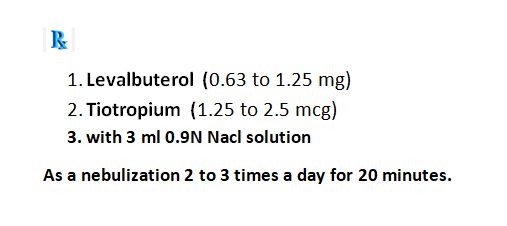
Here you should add 0.9N NaCl solution and total medication ratio should be 1:1:1.
Now this medication use with nebulization for 20 minutes interval until the symptoms disappeared or daily times for 7 days. If after 7 days symptoms are not disappeared you may extend it for more than 7 days or use when needed.
Who can’t use Prescription No 1 . Who are-
- High level arrhythmic patient ( heart rate more than 115)
With concern and may reduce the dose you may use prescription no 1.
Or you may use Prescription No 2 as a inhaler dose.

Or you may use Prescription No 3 as a combination of inhaler dose.

Two puffs 2 times daily for 7 days with other medicine as per rule. If after 7 days symptoms are not disappeared you may extend it for more than 7 days or use when needed.
Who can’t use Prescription No 3 . Who are-
- High level arrhythmic patient ( heart rate more than 115)
With concern and may reduce the dose you may use prescription no 3.
If prescription no 3 doesn’t work well you should take prescription no 4.
Prescription no 4:
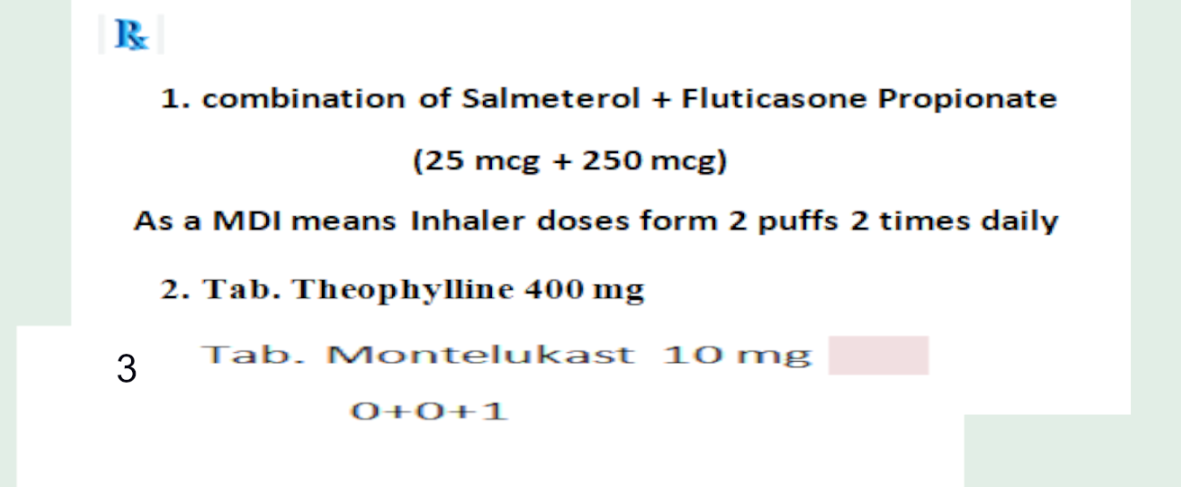
Medication should continue for 7 days with other medicine as per rule. If after 7 days symptoms are not disappeared you may extend it for more than 7 days or use when needed.
Who can’t use Prescription No 4 . Who are-
- High level arrhythmic patient ( heart rate more than 115)
With concern and may reduce the dose of medicine no 1 of this prescription you may use prescription no 4.
For more better feel you may use prescription no 5.
Prescription no 5:
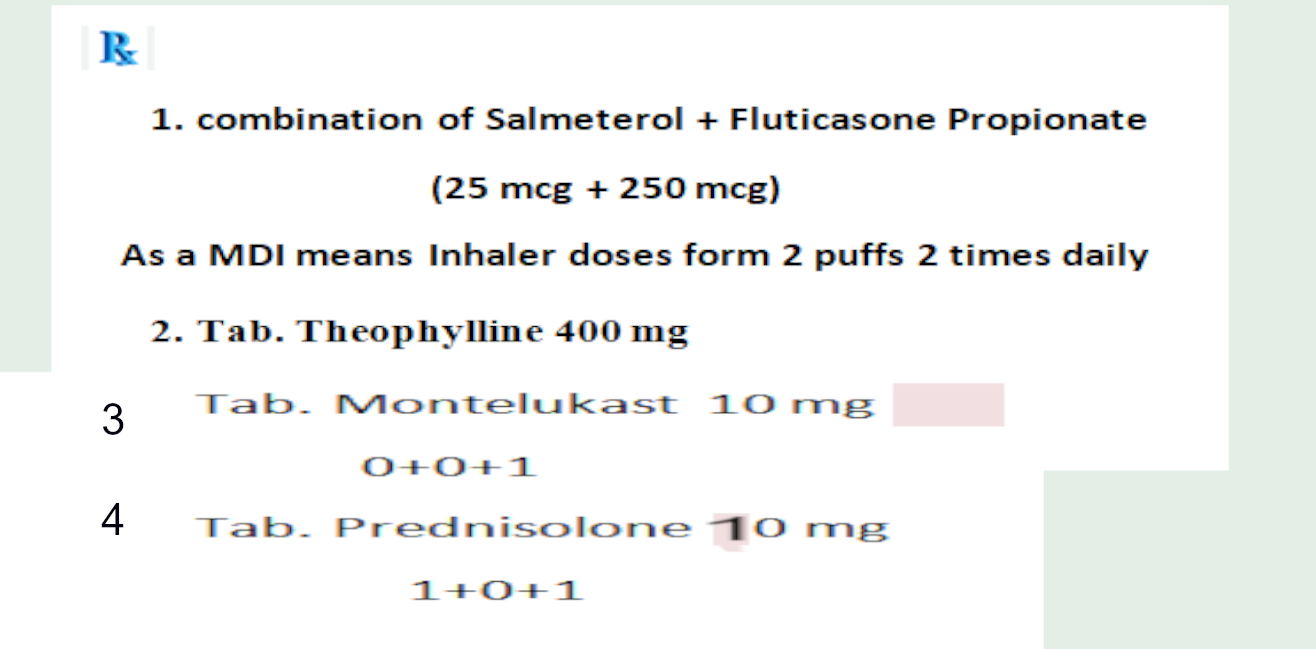
Medication should continue for 7 days with other medicine as per rule. If after 7 days symptoms are not disappeared you may extend it for more than 7 days or use when needed.
Who can’t use Prescription No 5 . Who are-
- High level arrhythmic patient ( heart rate more than 115)
With concern and may reduce the dose you may use prescription no 5 .
- Heart failure patient
- Severe liver cirrhosis patient
- Severe diabetics patient
- High level gastritis patient
- Pregnancy and lactation
In diabetics patient may omit the medicine no 4 or omit as prednisolone and gastritis patient may take a gastric suppression medicine before 30 minutes of meal then you can use the prescription no 5 . Or use prescription no 4.
For severe exacerbation patient it is better to ensure 6 to 15 hours oxygen supply until exacerbation is control.
If you don’t feel well or not improve the condition you should go to blood test for confirming bacteria or virus infection. If your blood test are shown as bacterial infection in lunges you may use the prescription no 6.
Prescription no 6:

Medication should continue for 7 days with other medicine as per rule. If after 7 days symptoms are not disappeared you may extend it for more than 7 days or use when needed without medicine no 3.
Who can’t use Prescription No 6 . Who are-
- High level arrhythmic patient ( heart rate more than 115)
With concern and may reduce the dose you may use of medicine no 1 in prescription no 6 .
- Heart failure patient
- Severe liver cirrhosis patient
- High level gastritis patient
Gastritis patient may take a gastric suppression medicine before 30 minutes of meal then you can use the prescription no 6 .
For severe exacerbation patient it is better to ensure 6 to 15 hours oxygen supply until exacerbation is control.
Prescription no 6 doesn’t work well if you are antibiotics azitromycin resistance. Using prescription no 6 if you don’t feel better within 3 days you should added another antibiotics in prescription no 6 for 7 days as prescription no 7.
Prescription no 7:

Who can’t use Prescription No 7 . Who are-
- High level arrhythmic patient ( heart rate more than 115)
With concern and may reduce the dose you may use of medicine no 1 in prescription no 7 .
- Heart failure patient
- Severe liver cirrhosis patient
- High level gastritis patient
Gastritis patient may take a gastric suppression medicine before 30 minutes of meal then you can use the prescription no 7 .
For severe exacerbation patient it is better to ensure 6 to 15 hours oxygen supply until exacerbation is control.
If enough cough produced in your lunges you may added more two medicine in prescription no 7.
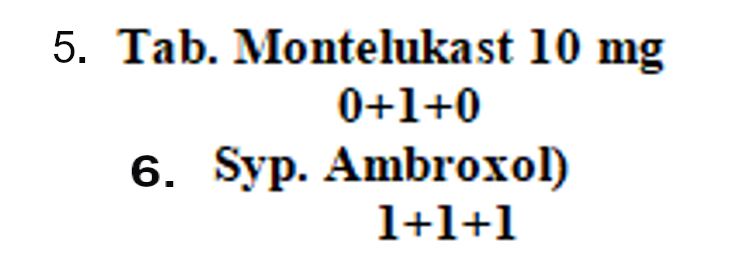
Medication should continue for 7 days with other medicine as per rule. If after 7 days symptoms are not disappeared you may extend it for more than 7 days or use when needed.
Note: If you don’t feel well you can take the prescription that are for moderate COPD patients. Beside the taking medication you should take exercise regularly.
Exercise
It is very important to take a deep breathing exercise 30 to 40 minutes a day that may improve asthma or COPD condition. Here I am suggesting a powerful deep breathing exercise that you may take regularly.
At first
You should sit on floor with folding leg then take breath and relax 30 to 40 times a minute for 10 minutes.
2nd
You should sit on floor with folding leg then take breath and relax 10 to 20 times a minute for 10 minutes.
3rd
You should sit on floor with folding leg then take breath and relax 3 to 5 times a minute for 10 minutes.
Advice
- That foods make COPD you should always avoid that foods and habits.
- Avoid allergens ( eg. Pollen, house dust mite, animal dander, mould, cockroach, food)Avoid
- Avoid occupational exposure ( eg. chemical irritants, frour , wood, textile dusts.)
- Immediate treatment viral respiratory tract infection.
- Should control exercise or use medicine before it begun.
- Should control your emotions ( eg, anxiety, Stress, hard laughter, crying).
- Should avoid exposure to irritants ( eg.Strong orders, chemicals, fumes ).
- Should avoid environmental exposure ( weather changes, cold air, Sulphur dioxide, cigarette smoke ).
- Should control using drugs like NSAID ( Aspirin, Ibuprofen etc ), Antiadrenergic and cholinergic drugs( eg. beta adrenergic blockers, Botanical).
Note: If you suffer sever COPD attack and don’t control at home you should go hospital immediately.
If anyone want to more information please send to me your question through the given email address.
Email address: mallicktarun@rocketmail.com For getting treatment base suggestion please contact or request an appointment.
You may also visit you tube video channel that may helpful to you.
